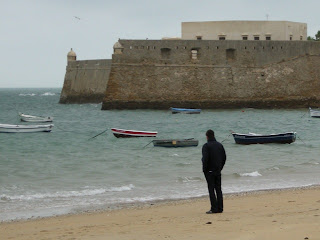
Okay, rather than lose you, three Spanish cities, Cartagena, Malaga and Cadiz, are going into one posting and - boy! - it's delightful to be in late autumn Southern Europe. Empty boardwalks and the usual battle for a mid-morning coffee at a sidewalk cafe are things of the high-season past. Bored waiters who, a few weeks ago, would do their best to ignore you, look hopeful as you approach.
Even a beach - this is Cadiz - on a misty, blustery afternoon is rewarding.
In Malaga, foreigners who denounce bullfighting, but have never seen a slaughterhouse, are reduced to a low-season rump. However, I did spot some local dissatisfaction with the city's toreadors.
Still, you have to admit the posters are good.
I was surprised to find the gates to the bullring open and, having never seen one, walked in. I more or less had it to myself. Impressive with lots of nice, fresh sand waiting to soak up the next bout's aftermath.
Not only the bullfight, but the seats would likely put me off from sitting through an afternoon. They might even put off Molly Bloom.
A few quick pictures to conclude. This was taken near the bullring, the protective covering on a building being restored.
One of my favourite squares in Malaga - one I always visit - has a statue of Ibn Gabirol, an 11th Century Jewish poet and philosopher, and a photogenic passageway.
It was Rupert Brooke who said something to the affect of Canada has no ghosts; that is, Canada has such a short recorded history compared with Europe. It's blindingly obvious, but in a place such as Spain, violent history is everywhere.
In Cadiz, a plaque honours a Spaniard - the Trafalgar foe we don't remember much - who died from wounds in the battle.
And in Cartagena, tucked away in a museum's dark corner, the old tyrant, Franco, looks down from a wall.











